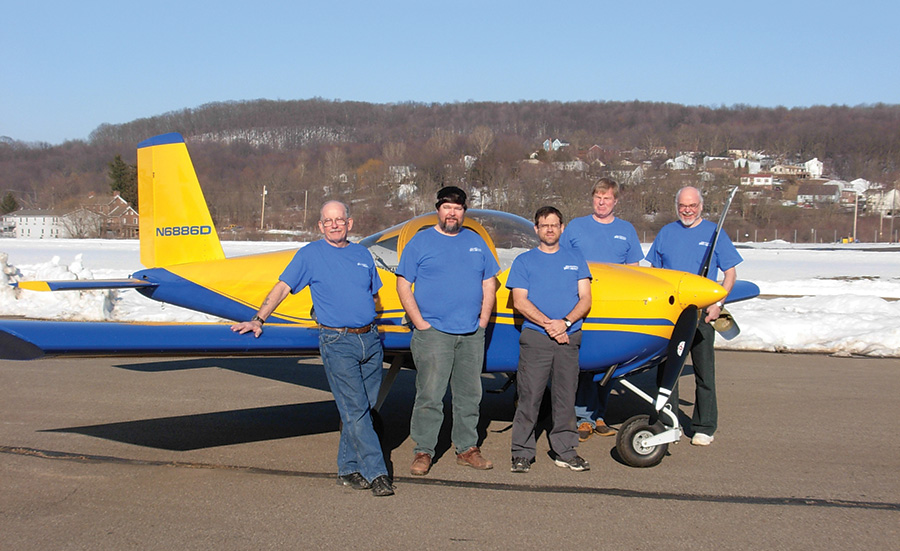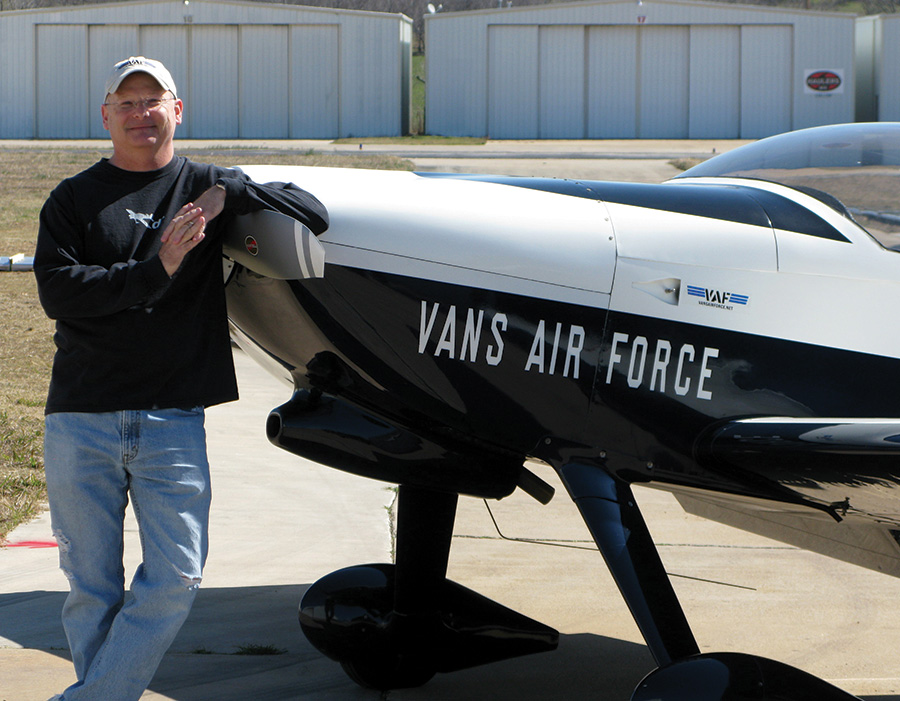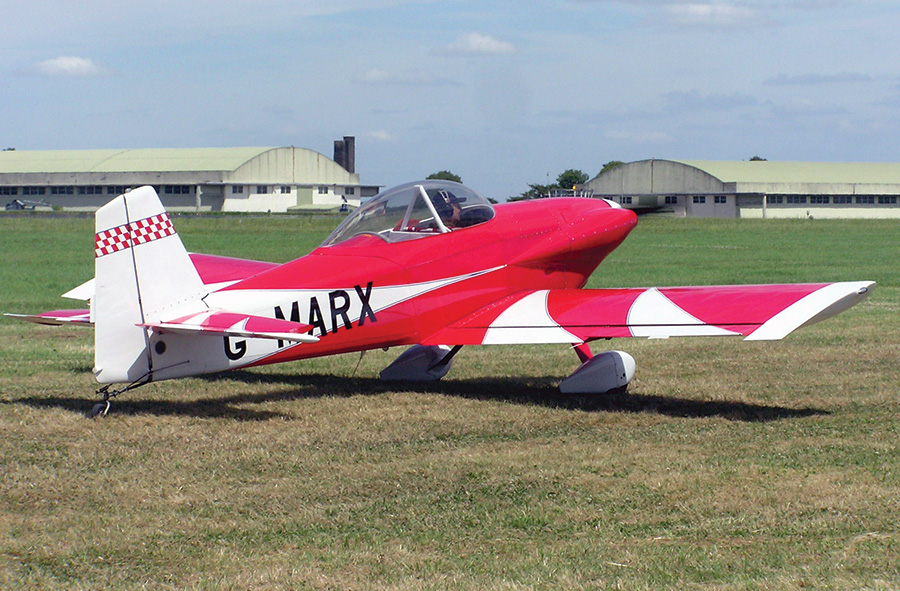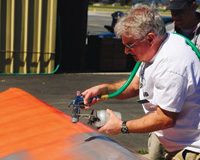Shortly after the dinosaurs died, I learned to fly. At the time, a gallon of avgas cost about 30% of the federal hourly minimum wage, and you had your choice of 80 or 100 octane. Today, it’s 100LL and costs about 60% of the same benchmark. And that’s just fuel. In those halcyon days, I could rent a Cessna 152 and putter around for an hour for a cost of about seven times the minimum wage. Today that proportion is at least 10:1 and usually more—for the same, exact airplane. The first hangar I rented cost about 7% of my gross monthly income at the time. Many years later, that same hangar rents for about 13% of my much larger wage.
It’s never been easy to afford flying, and it’s getting harder. So, how to stay in the game?
There are only a few strategies: make more money, spend less, or get somebody else to pay part of the tariff.

Chuck Lotz formed a group of friends into a team to build and fly an RV-12. Their success is a model for others.
Make More Money
The “make more money” part sounds facile. After all, most of us are working harder than ever—statistics show Americans working more hours and taking less time off than they did 30 years ago. If it was so darn easy to just make more money, we’d already be doing it.
Well, it isn’t easy, but most of us do have some skill or ability we can sell. Articles need to be written (English majors…) garage sales hosted, airplanes and cars washed (English majors, again, I fear). I used to joke about picking up enough pop cans along the highway to pay for my flying. It was a joke, at least, until a fellow in Washington State actually did it. According to an article in General Aviation News, this entrepreneur walked a couple miles each way to work, carrying a bag and picking up all the recyclable cans he could find. Not only did he keep fit, but he made enough in two years to buy a partnership in an old Aeronca.
Spend Less

Doug Reeves figured out how to cut everyday costs without hurting his family; the result was affordable aircraft ownership.
Internet-savvy Texan Doug Reeves dug up his flying cash by starting a web site catering to the RV crowd. It slowly started generating some income, but he needed more to fund his flying. Some years ago, he posted an article explaining how he found the money to complete and fly his RV-6 without asking excessive sacrifices from his family. I’ve paraphrased his points, but you can read the entire article on www.vansairforce.net.
1. Don’t buy a new car every 2-3 years—saves $350 a month. Two old cars averaging 230,000 miles, but getting 20-25 mpg, get us around safely and reasonably reliably. Insurance on the old beaters is about $1/day.
2. Cancel cable TV—Saves $40 a month. We don’t miss it a bit.
3. Take a sack lunch to work or have breakfast at home—saves $120 a month. Eating out every day? Do the math.
4. Have the money you’ve freed up deposited directly into a separate savings account so you never see it. Use this money only for flying.
Since that was written, Doug has parlayed his part-time web site into a lucrative full time career and basks in wealth beyond the wildest dreams of avarice. Even better, he flies regularly. You’ll notice he doesn’t recommend canceling your Internet connection.
Share The Costs
If all the economies you can make don’t quite cut it, there’s always another possibility—possibly the best alternative. Let somebody else pay for your flying. Or at least, pay for part of it. Airplanes, unlike cars, are excellent vehicles for partnerships. Splitting the acquisition cost, insurance, maintenance and shelter several ways leaves a lot more to spend in the irreducible operational expense. I have been a partner in two different airplanes with several different people. Not only did it make flying more affordable, but knowing and working with these people increased my enjoyment of the aircraft significantly.
Not long after getting my license (and my first paying job), I started casting about for an affordable flying situation. I found an elderly 1965 Champion with a Continental O-200 engine. I could never decide whether it was an overweight Champ or an underpowered Citabria. It was owned by a local partnership, by which I mean that just about everybody local had been a partner at one time or another. I bought my fifth share from an outgoing member for the grand sum of $1,250. It flew like a sprained ankle, but I flew it more than the other four partners put together. We kept a logbook in the airplane and paid a fixed rate per hour flown. We bought our own fuel. Fixed costs like hangar and insurance were split evenly. One partner kept the books and handled scheduling—which wasn’t too hard because the airplane was too slow to leave town. We arranged work parties for annuals and any necessary maintenance. It all worked fine, except for one partner. He almost never flew the airplane, never made payments on time and certainly never showed up to work. We called him Parasite D. Rag, and we eventually forced him to come to a meeting where we voted him out, gave him a fair sum for his share and sent him on his way. He was not happy, but the rules of the partnership agreement allowed it. It taught me that a partnership agreement without a few teeth was useless. I built an RV-6 and left the Citabria behind, but it served its purpose and I have good memories of the camaraderie and pleasure it gave us all.
Building a Partnership
Certified airplanes are one kind of partnership—but there’s another path. You can band together to build an airplane, thereby defraying a significant part of the acquisition costs with labor. This makes a lot of sense because building an airplane is a demanding—sometimes discouraging—proposition, and there’s no denying that many hands make light work. But in this case, it’s even more essential that everyone is on the same page. Phillip Groelz was in on the beginning of a chapter project that looked great at the beginning—low buy-in costs and plenty of enthusiastic hands.
“The idea was that members could get hands-on experience with the building process, without either the financial or time commitment of individual ownership,” Phillip remembers. “We sold shares for $100 each with the idea that when completed, a flying club would be formed. The project stalled out at the same point as a lot of rag-and-tube projects do. The wings were nearly ready for cover and the fuselage was on the gear.”
One of the problems was that the project had a small core of dedicated builders and an electron cloud of pop-up volunteers. The mix slowed progress dramatically.
“During a first visit, less was usually accomplished than if the leader were working by himself,” Phillip says, speaking as one of the mentor builders. “By a third session, if there was one, the volunteer would usually need little supervision and could contribute usefully. But by that point, a lot of time had been spent.” Almost twenty years later, he’s taken the long-stalled project home and is finishing it himself.
I’m convinced that a plansbuilt rag- and-tube airplane requires at least two man-years, and more if the learning curves of a lot of individuals are added in. My advice? If the goal is a flying aircraft, get a kit. The better the kit, the better the chances of completion.
Was the project a failure? For those who considered the building to be work and wanted the finished airplane, maybe so. For others, for whom the work was time better spent than the usual alternatives of TV and lawn care, it was worthwhile.
As expensive as flying has become, there are choices. In the sidebars, are two excellent examples of how dedicated people made group projects work for them.
Hold a bake sale, pick up your tools, find some partners. Do what you need to do, but stay in the game.

![]()
Ken Scott is a longtime employee of Van’s Aircraft and also a multi-airframe builder (RV-6, KK-1, RV-12) whose quest for new skills remains unabated. He lives with his wife, Camilla, on a residential airpark near Canby, Oregon.





